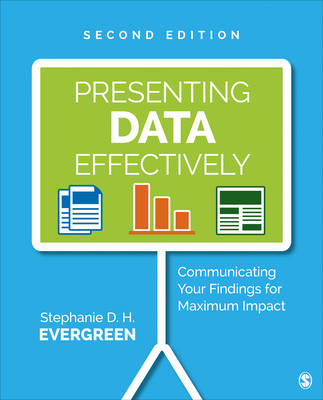
Presenting Data Effectively
Corwin Press Inc (Verlag)
978-1-5063-5312-8 (ISBN)
Principles related to graphics, color, placement, and typeface are illustrated through before-and-after cases submitted to and developed by the author, primarily using the standard software in Microsoft Office. The Second Edition, now in full color, includes the author's most recent thinking and experience, a review of the recent literature on data visualization, and an improved layout with larger screenshots.
Presenting Data Effectively teaches how color and text can be applied with graphics and arranged in such a way that posters, slides, graphs, and reports communicate your data effectively. The author's companion book, Effective Data Visualization is all about how to choose the right chart for your data and then how to construct it, step by step, using Excel so that it tells your story.
Dr. Stephanie Evergreen is an internationally-recognized speaker, designer, and researcher. She is best known for bringing a research-based approach to helping researcher better communicate their work through more effective graphs, slides, and reports. She holds a PhD from Western Michigan University in interdisciplinary evaluation, which included a dissertation on the extent of graphic design use in written research reporting. Dr. Evergreen has trained researchers worldwide through keynote presentations and workshops, for clients including Time, Verizon, Head Start, American Institutes for Research, Rockefeller Foundation, Brookings Institute, and the United Nations. She is the 2015 recipient of the American Evaluation Association's Guttentag award, given for notable accomplishments early in a career. Dr. Evergreen is co-editor and co-author of two issues of New Directions for Evaluation on data visualization.
Chapter 1: The Justification for Presenting Data Effectively Learning Objectives What Does Effective Data Presentation Look Like? What Makes Data Presentation Effective? What Do I Need to Develop Effective Data Presentation? How Do I Navigate This Book? What Is the Bottom Line? Key Points to Remember How Can I Extend This? Where Can I Go for More Information? Chapter 2: Graphics Learning Objectives Guiding Ideas How Do I Use Images in Effective Ways? How Do I Efficiently Locate High-Quality Images? Where Should Graphs Go? How Do I Apply These Ideas to Graphs? What Is the Bottom Line? Key Points to Remember How Can I Extend This? Where Can I Go for More Information? Chapter 3: Text Learning Objectives Guiding Ideas What Is Type? How Do I Tell These Typefaces Apart? What Works for Paper and What Works for Screen? How Can I Protect Font Choices? How Do Fonts Actually Communicate? How Big Should I Make My Narrative Typeface? How Large Should I Make My Heading Typeface? How Should Lines Be Spaced? How Does Typeface Help Organize Data Presentation? How Do I Apply These Ideas to Graphs? What Is the Bottom Line?' Key Points to Remember How Can I Extend This? Where Can I Go for More Information? Chapter 4: Color Learning Objectives Guiding Ideas Why Is Color Important to Memory? What Colors Should I Choose? What Should I Watch Out For? How Do I Apply Emphasis Colors? How Do I Apply These Ideas to Graphs? What Is the Bottom Line? Key Points to Remember How Can I Extend This? Where Can I Go for More Information? Chapter 5: Arrangement Learning Objectives Guiding Ideas Where Do the Bits and Pieces Go? Do I Need to Do Anything About Margins? How Should I Justify Text? How Can I Align Using Typical Software? When Is It Okay to Break the Rules? How Do I Apply These Ideas to Graphs? What Is the Bottom Line? Key Points to Remember How Can I Extend This? Where Can I Go for More Information? Chapter 6: A Short Last Word on Presenting Data Effectively Learning Objectives Criticism: Trying to Look Slick Benefit 1: Fits with How the Brain Operates Benefit 2: Adds to Credibility and Competence Criticism: Design Is Expensive Benefit 3: There Are Multiple Ways to Save Time Key Points to Remember How Can I Extend This? Where Can I Go for More Information?
| Erscheinungsdatum | 22.06.2017 |
|---|---|
| Verlagsort | Thousand Oaks |
| Sprache | englisch |
| Gewicht | 28 g |
| Themenwelt | Informatik ► Datenbanken ► Data Warehouse / Data Mining |
| Sozialwissenschaften ► Pädagogik | |
| Sozialwissenschaften ► Soziologie ► Allgemeines / Lexika | |
| Sozialwissenschaften ► Soziologie ► Empirische Sozialforschung | |
| ISBN-10 | 1-5063-5312-6 / 1506353126 |
| ISBN-13 | 978-1-5063-5312-8 / 9781506353128 |
| Zustand | Neuware |
| Informationen gemäß Produktsicherheitsverordnung (GPSR) | |
| Haben Sie eine Frage zum Produkt? |
aus dem Bereich


